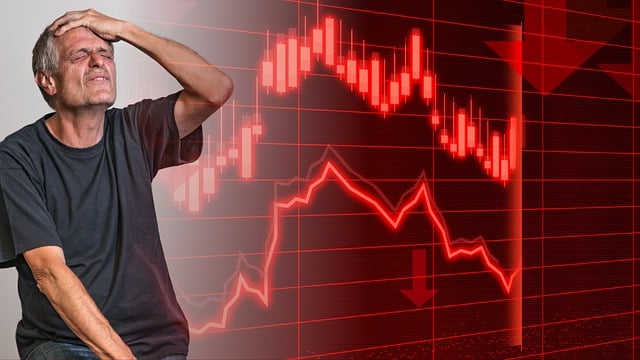Anatomy of a Stock Market Crash + Survival Strategies for 2025

The term stock market crash sends shivers down the spines of even the most seasoned investors. Defined by sharp and sudden declines in market values, crashes have historically disrupted economies, wiped out trillions in wealth, and fueled widespread panic.
Fast-forward to 2025, and an economic climate riddled with trade wars, rising interest rates, and global instability has made the stock market ecosystem particularly volatile. Could we learn something from the past to mitigate future risks? This blog dives deep into what defines a crash, explores historical patterns, and shares actionable investment strategies to weather the storm.
What Is a Stock Market Crash?
A stock market crash refers to a rapid, often unanticipated, drop in stock prices across a significant portion of the market. The fallout usually stems from a combination of factors like economic policies, market sentiment, and world events.

To clarify, here’s how a crash differs from related terms:
-
Market correction: A decline of 10%–20% in stock prices, typically short-lived and part of routine market fluctuations.
-
Bear market: A prolonged downturn where stock prices fall 20% or more, often signaling widespread pessimism.
Anatomy of a Crash: Key Triggers
Several triggers contribute to a stock market crash. Here are the big players you need to watch closely:
1. Economic Policies
Government policies on interest rates and inflation often set the stage for market instability. Sudden interest rate hikes, combined with stagnating economic growth, usually lead to illiquidity and panic among investors.
2. Geopolitical Risks and Black Swan Events
Conflicts, trade embargoes, and pandemics are prime examples of black swan events that can send markets spiraling out of control. The global nature of modern markets makes them highly susceptible to sudden geopolitical shifts.
3. Investor Psychology
The human factor plays a critical role in crashes. A herd mentality amplified by panic selling often exacerbates the downward spiral. Behavioral economics shows how fear and irrational decision-making thrive in uncertain markets.

By understanding these triggers, both investors and students can begin identifying early warning signs before a crash escalates.
A Timeline of Major Crashes
History presents a wealth of lessons on financial crises and recoveries. Here’s an overview of some notable stock market crashes:
1. The 1929 Crash
The Great Depression’s precursor, this devastating crash erased 89% of the Dow’s value from 1929 to 1932, triggered by excessive speculation and borrowing on margin.
2. The 1987 Black Monday
Postmodern trading saw its first major disruption when the Dow dropped 22.6% in a single day due to program trading strategies gone wrong.
3. The 2008 Global Financial Crisis
Fueled by reckless subprime mortgages, Lehman Brothers' collapse sent shockwaves into global markets, resulting in a full-blown recession.
4. The 2025 Crash (Latest Update)
This year's crash marks one of the most volatile economic events the market has seen in decades, thanks to escalating trade tariffs and suppressed global confidence.
(Insert data chart visualizing the scale of past crashes vs. 2025’s crash)
How the 2025 Crash Unfolded
The 2025 Stock Market Crash was a cocktail of unfortunate triggers:
-
Rising trade tensions between heavyweight economies led to reduced international investment flows.
-
Drastic interest rate increases from central banks eroded investor confidence.
-
Panic selling caused sectors like tech and financial services to plummet by over 30%.
Market responses mirrored a pessimistic sentiment, with many retail investors exiting positions prematurely, often realizing heavy losses.
Hidden Patterns in History
History has a habit of repeating itself. When it comes to crashes, many indicators are surprisingly cyclical.
-
Investor Behavior Cycles
Fear and greed dominate investors’ psychology. During market booms, excessive optimism inflates prices until unsustainable valuations cause inevitable corrections.
-
Predictable Crash Signals
Indicators like the Buffett Indicator (market cap-to-GDP ratio) and the VIX (volatility index) often spike months before market crashes.
-
Forgotten Crashes
Lesser-known panics, like that of 1907, remind us that the health of financial institutions directly impacts stock market stability. Skimming over history only guarantees more costly mistakes.
Economic Ripple Effects
Stock market crashes don’t exist in a vacuum. Their effects spread across the economy, impacting various sectors:
-
Employment Decline
Layoffs typically follow major market crashes, as companies strive to cut costs amid lower revenues.
-
Credit Markets Freeze
Borrowing becomes riskier, leading to tightened lending conditions, stifled consumer spending, and slower economic growth.
-
Psychological Toll
Massive wealth destruction shakes people’s confidence in financial markets, leading to irrational decisions like withdrawing 401ks or halting investments altogether.
Protecting Your Investments During a Crash
When faced with an economic downturn, here’s how to shield your portfolio and seize opportunities:
1. Diversify Your Portfolio
Allocate investments across asset classes like stocks, bonds, and real estate to reduce risk exposure.
2. Focus on Defensive Assets
Turn to cash reserves, gold, and Treasury bonds that historically perform well during downturns.
3. Consider Robo-advisors
AI-based platforms can help optimize portfolio performance and rebalance automatically in response to market fluctuations.
4. Avoid Emotional Decisions
Stick to long-term goals and avoid selling based on panic. Remember: the market will eventually recover.
What Experts Predict Next
Economists and AI-based forecasting models project a slow but steady recovery from the 2025 crash. Increased reliance on automation and AI investment strategies will likely stabilize the markets, though global policies remain unpredictable.
“The key to navigating a post-crash market is staying patient and keeping an eye on fundamentals," says Dr. Elena Maxwell, a renowned financial strategist.
Analysts also suggest that smaller investors might see better opportunities in emerging markets, which seem to bounce back faster than major economies.
Frequently Asked Questions (FAQs)
Q1. What should I do during a stock market crash?
Stay calm, avoid panic selling, and focus on long-term strategies like diversification and dollar-cost averaging.
Q2. Can beginners invest during a crash?
Yes! Crashes often present discounted buying opportunities in key sectors, but thorough research is essential.
Q3. How long does it take to recover from a crash?
Recovery periods vary, but major markets typically bounce back within a few years.
Lessons from Crashes Past and Present
Understanding the anatomy of a stock market crash equips you with the foresight to turn financial crises into opportunities. By studying historical trends, leveraging technology, and employing sound investment strategies, you can confidently face uncertainty in an era of economic downturns.
To make smarter investment choices, consider signing up for robo-advisors or financial tools tailored to your needs. Building wealth doesn’t happen overnight. It’s a steady process driven by resilience and informed decision-making.
